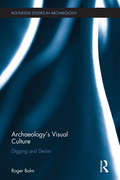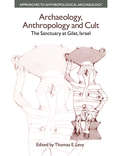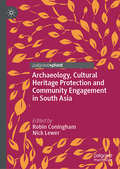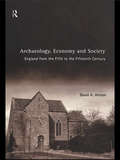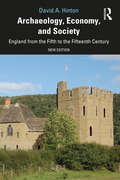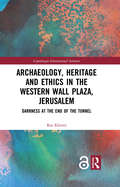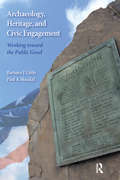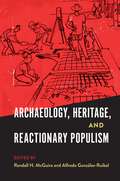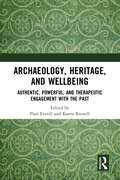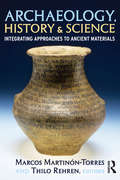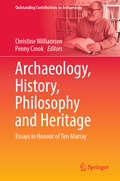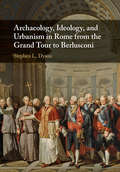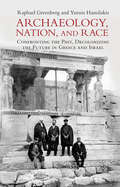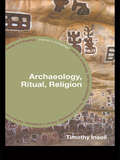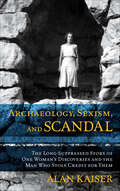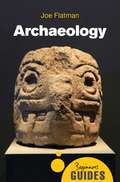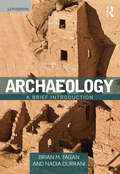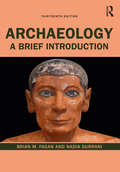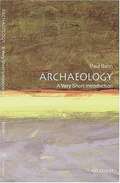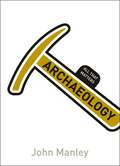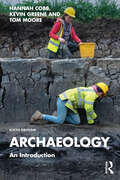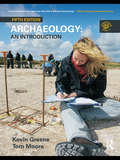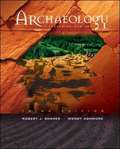- Table View
- List View
Archaeology to Delight and Instruct: Active Learning in the University Classroom (One World Archaeology Ser. #49)
by Heather Burke Claire SmithThis book presents novel and interesting ways of teaching archaeological concepts and processes to college and university students. Seeking alternatives to the formal lecture format, the various contributions seek better ways of communicating the complexities of human behavior and of engaging students in active learning about the past. This collection of imaginative exercises designed by 20 master instructors on three continents includes role-playing, games, simulations, activities, and performance, all designed to teach archaeological concepts in interesting and engaging ways.
Archaeology's Visual Culture: Digging and Desire (Routledge Studies in Archaeology)
by Roger BalmArchaeology’s Visual Culture explores archaeology through the lens of visual culture theory. The insistent visuality of archaeology is a key stimulus for the imaginative and creative interpretation of our encounters with the past. Balm investigates the nature of this projection of the visual, revealing an embedded subjectivity in the imagery of archaeology and acknowledging the multiplicity of meanings that cohere around artifacts, archaeological sites and museum displays. Using a wide range of case studies, the book highlights how archaeologists can view objects and the consequences that ensue from these ways of seeing. Throughout the book Balm considers the potential for documentary images and visual material held in archives to perform cultural work within and between groups of specialists. With primary sources ranging from the mid-nineteenth to the early twenty-first century, this volume also maps the intellectual and social connections between archaeologists and their peers. Geographical settings include Britain, Cyprus, Mesoamerica, the Middle East and the United States, and the sites of visual encounter are no less diverse, ranging from excavation reports in salvage archaeology to instrumentally derived data-sets and remote-sensing imagery. By forensically examining selected visual records from published accounts and archival sources, enduring tropes of representation become apparent that transcend issues of style and reflect fundamental visual sensibilities within the discipline of archaeology.
Archaeology, Anthropology and Cult: The Sanctuary at Gilat,Israel
by Thomas Evan LevyThe Chalcolithic period was formative in Near Eastern prehistory, being a time of fundamental social change in craft specialization, horticulture and temple life. Gilat - a low mound, semi-communal farming settlement in the Negev desert - is one of the few Chalcolithic sanctuary sites in the Southern Levant. 'Archaeology, Anthropology and Cult' presents a critical analysis of the archaeological data from Gilat. The book brings together archaeological finds and anthropological theory to examine the role of religion in the evolution of society and the power of ritual in promoting change. This comprehensive volume, which includes artefact drawings, photographs, maps and data tables, will be of interest to students and scholars of ancient history, anthropology, archaeology, as well as biblical and religious studies.
Archaeology, Cultural Heritage Protection and Community Engagement in South Asia
by Robin Coningham Nick LewerExploring archaeology, community engagement and cultural heritage protection in South Asia, this book considers heritage management strategies through community engagement, bringing together the results of research undertaken by archaeologists, heritage practitioners and policy makers working towards the preservation and conservation of both cultural and natural heritage. The book highlights the challenges faced by communities, archaeologists and heritage managers in post-conflict and post-disaster contexts in their efforts to protect, preserve and present cultural heritage, including issues of sustainability, linkages with existing community programmes and institutions, and building administrative and social networks. The case-studies illustrate larger-scale projects to small micro-level engagement, across a range of geographical, political, social and economic contexts, providing a framework that links and synchronises programmes of archaeological activities alongside active community engagement. The chapters ‘Introduction’, ‘Community Engagement in the Greater Lumbini Area of Nepal: the Micro-Heritage Case-Study of Dohani’ and ‘Conclusion’ of this book are available open access under a CC BY 4.0 license at link.springer.com.
Archaeology, Economy and Society: England from the Fifth to the Fifteenth Century
by David A. HintonMany books have been written on particular aspects of medieval archaeology, or on particular parts of the period, but synthesis across the whole spectrum has not been attempted before. The aim of this book is to examine the contribution that archaeology can make to an understanding of the social, economic, religious and other developments that took place in England from the migrations of the fifth and sixth centuries to the beginning of the Renaissance, showing how society and economy evolved in that time-span.Drawing on the latest available material, the book takes a chronological approach to the archaeological material of the post-Roman period in order to emphasize the changes that can be observed in the physical evidence and some of the reasons for them that can be suggested. The environment in which people functioned and how they expressed themselves - for example in their houses and burial practices, their pottery and their clothes - show how they were constrained by social customs and economic pressures.
Archaeology, Economy, and Society: England from the Fifth to the Fifteenth Century
by David A. HintonThis book examines the contribution of archaeology to the study of the social, economic, religious, and other developments in England from the end of the Roman period at the start of the fifth century to the beginnings of the Renaissance at the end of the fifteenth century. The first edition of the book was published in 1990, and remains the only synthesis of the whole spectrum of medieval archaeology. This new edition is completely rewritten and extended, but uses the same chronological approach to investigate how society and economy evolved. It draws on a wide range of new data, derived from excavation, investigation of buildings, metal-detection, and scientific techniques. It examines the social customs, economic pressures, and environmental constraints within which people functioned; the technology available to them; and how they expressed themselves, for example in their houses, their burial customs, their costume, and their material possessions such as pottery. Their adaptation to new circumstances, whether caused by human factors such as the re-emergence of towns or changing taxation requirements, or by external ones such as volcanic activity or the Black Death, is explored throughout each chapter. The new edition of Archaeology, Economy, and Society will be essential reading for students and researchers of the archaeology of Medieval England.
Archaeology, Heritage and Ethics in the Western Wall Plaza, Jerusalem: Darkness at the End of the Tunnel
by Raz KletterThis volume is a critical study of recent archaeology in the Western Wall Plaza area, Jerusalem. Considered one of the holiest places on Earth for Jews and Muslims, it is also a place of controversy, where the State marks ‘our’ remains for preservation and adoration and ‘theirs’ for silencing. Based on thousands of documents from the Israel Antiquities Authority and other sources, such as protocols of planning committees, readers can explore for the first time this archaeological ‘heart of darkness’ in East Jerusalem. The book follows a series of unique discoveries, reviewing the approval and execution of development plans and excavations, and the use of the areas once excavation has finished. Who decides what and how to excavate, what to preserve – or ‘remove’? Who pays for the archaeology, for what aims? The professional, scientific archaeology of the past happens now: it modifies the present and is modified by it. This book ‘excavates’ the archaeology of East Jerusalem to reveal its social and political contexts, power structures and ethics. Readers interested in the history, archaeology and politics of the Israeli-Palestinian conflict will find this book useful, as well as scholars and students of the history and ethics of Archaeology, Jerusalem, conservation, nationalism, and heritage.
Archaeology, Heritage, and Civic Engagement: Working toward the Public Good
by Barbara J Little Paul A ShackelThe definition of “public archaeology” has expanded in recent years to include archaeologists’ collaborations with and within communities and activities in support of education, civic renewal, peacebuilding, and social justice. Barbara Little and Paul Shackel, long-term leaders in the growth of a civically-engaged, relevant archaeology, outline a future trajectory for the field in this concise, thoughtful volume. Drawing from the archaeological study of race and labor, among other examples, the authors explore this crucial opportunity and responsibility, then point the way for the discipline to contribute to the contemporary public good.
Archaeology, Heritage, and Reactionary Populism (Cultural Heritage Studies)
by Alfredo González-Ruibal Randall H. McGuireA timely collection on the role of public archaeology in an era of reactionary populism Reactionary populism, seen in radical anti-intellectual movements around the globe, is changing how politics are practiced and how people view themselves and others. Amid increasing polarization and extremism, the social role of archaeology is more relevant but also more difficult. This volume explores how populist politics present new challenges to public archaeologists in North America, South America, and Europe. Archaeology, Heritage, and Reactionary Populism shows that the field of community archaeology must do more to address how these movements can distort history. Contributors demonstrate why researchers and heritage managers should be aware of the interests their work advances, discuss the ethics of working with communities that promote extreme populist values, and examine the ways governments affect heritage regulations. Acknowledging that community archaeology is often very localized, they argue that it can and should connect with and inform broader historical narratives. Written by practitioners from different subfields of public archaeology, this collection problematizes commonly held assumptions about community, the public, and political action. At the same time, it moves beyond critique to propose practical forms of engagement. This reflective and critical approach will help archaeologists mobilize their work to engage with the growing influence of reactionary populism. A volume in the series Cultural Heritage Studies, edited by Katherine Hayes
Archaeology, Heritage, and Wellbeing: Authentic, Powerful, and Therapeutic Engagement with the Past
by Paul EverillArchaeology, Heritage, and Wellbeing fills an important gap in the academic literature, bringing together experts from archaeology/ historic environment and mental health research to provide an interdisciplinary overview of this emerging subject area. The book, uniquely, provides archaeologists and heritage professionals with an introduction to the ways in which mental health researchers view and measure wellbeing, helping archaeologists and other heritage professionals to move beyond the anecdotal when evaluating the strengths and weaknesses of such initiatives. Importantly, this book also serves to highlight to mental health researchers the many ways in which archaeology and heritage can be, and are being, harnessed to support non-medical therapeutic interventions to improve wellbeing. Authentic engagement with the historic environment can also provide powerful tools for community health and wellbeing, and this book offers examples of the diverse communities that have benefited from its capacity to promote wellbeing and wellness. Archaeology, Heritage, and Wellbeing is for students and researchers of archaeology and psychology interested in wellbeing, as well as researchers and professionals involved in health and social care, social prescribing, mental health and wellbeing, leisure, tourism, and heritage management.
Archaeology, History and Science: Integrating Approaches to Ancient Materials (UCL Institute of Archaeology Publications)
by Marcos Martinón-TorresUsing a combination of historical, archaeological, and scientific data is not an uncommon research practice. Rarely found, however, is a more overt critical consideration of how these sources of information relate to each other, or explicit attempts at developing successful strategies for interdisciplinary work. The authors in this volume provide such critical perspectives, examining materials from a wide range of cultures and time periods to demonstrate the added value of combining in their research seemingly incompatible or even contradictory sources. Case studies include explorations of the symbolism of flint knives in ancient Egypt, the meaning of cuneiform glass texts, medieval metallurgical traditions, and urban archaeology at industrial sites. This volume is noteworthy, as it offers novel contributions to specific topics, as well as fundamental reflections on the problems and potentials of the interdisciplinary study of the human past.
Archaeology, History, Philosophy and Heritage: Essays in Honour of Tim Murray (Outstanding Contributions to Archaeology)
by Penny Crook Christine WilliamsonThis festschrift volume celebrates Tim Murray&’s significant and wide-ranging contribution to archaeological thought and practice. It includes 27 papers by Tim Murray&’s colleagues, research collaborators and students—former and current. Together these comprise a substantive and reflective contribution to Archaeology, History, Philosophy and Cultural Heritage in Australia, Oceania, China, India, the United Kingdom, Northern Europe, and North America. The collected papers in this volume tie together Murray&’s research into the history (or historiography) of archaeological thought, and his commitment to understanding the material culture of the past to &‘write history&’. They provide a cross-section of philosophical enquiries and substantive research: from epistemological studies of shared lexicons and important debates in the history of archaeological thought, to the minutae of material culture studies. Several papers explcitly and implicitly explore one of Murray&’s great interests: the role of heritage preservation in our exploration of the past, including dedicated tertiary training programs for Indigenous Australians to manage, research and protect their own Country. The book is divided into four parts: History, Archaeology, Philosophy and Heritage, offering an interdisciplinary approach to the study of the past. This volume would be of interest to archaeologists, historians, philosophers of archaeology, and heritage scholars.
Archaeology, Ideology, and Urbanism in Rome from the Grand Tour to Berlusconi
by Stephen L. DysonRome is one of the world's greatest archaeological sites, preserving many major monuments of the classical past. It is also a city with an important post-Roman history and home to both the papacy and the modern Italian state. Archaeologists have studied the ruins, and popes and politicians have used them for propaganda programs. Developers and preservationists have fought over what should and should not be preserved. This book tells the story of those complex, interacting developments over the past three centuries, from the days of the Grand Tour through the arrival of the fascists, which saw more destruction but also an unprecedented use of the remains for political propaganda. In post-war Rome, urban development predominated over archaeological preservation and much was lost. However, starting in the 1970s, preservationists have fought back, saving much and making the city into Europe's most important case study in historical preservation and historical loss.
Archaeology, Nation, and Race: Confronting the Past, Decolonizing the Future in Greece and Israel
by Yannis Hamilakis Raphael GreenbergArchaeology, Nation, and Race is a must-read book for students of archaeology and adjacent fields. It demonstrates how archaeology and concepts of antiquity have shaped, and have been shaped by colonialism, race, and nationalism. Structured as a lucid and lively dialogue between two leading scholars, the volume compares modern Greece and modern Israel – two prototypical and influential cases – where archaeology sits at the very heart of the modern national imagination. Exchanging views on the foundational myths, moral economies, and racial prejudices in the field of archaeology and beyond, Hamilakis and Greenberg explore topics such as the colonial origins of national archaeologies, the crypto-colonization of the countries and their archaeologies, the role of archaeology as a process of purification, and the racialization and 'whitening' of Greece and Israel and their archaeological and material heritage. They conclude with a call for decolonization and the need to forge alliances with subjugated communities and new political movements.
Archaeology, Ritual, Religion (Themes in Archaeology Series)
by Timothy InsollThe archaeology of religion is a much neglected area, yet religious sites and artefacts constitute a major area of archaeological evidence. Timothy Insoll presents an introductory statement on the archaeology of religion, examining what archaeology can tell us about religion, the problems of defining and theorizing religion in archaeology, and the methodology, or how to 'do', the archaeology of religion.This volume assesses religion and ritual through a range of examples from around the world and across time, including prehistoric religions, shamanism, African religions, death, landscape and even food. Insoll also discusses the history of research and varying theories in this field before looking to future research directions. This book will be a valuable guide for students and archaeologists, and initiate a major area of debate.
Archaeology, Sexism, and Scandal: The Long-Suppressed Story of One Woman's Discoveries and the Man Who Stole Credit for Them
by Alan KaiserA true story of plagiarism, complicity, and a 1930s excavation that &“has the arresting immediacy of investigative journalism&” (The Journal of Hellenic Studies). The 1931 excavation season at Olynthus, Greece, ushered a sea change in how archaeologists study material culture—and was the nexus of one of the most egregious (and underreported) cases of plagiarism in the history of classical archaeology. In this book, Alan Kaiser draws on the private scrapbook that budding archaeologist Mary Ross Ellingson compiled during that dig, as well as her personal correspondence and materials from major university archives, to paint a fascinating picture of gender, power, and archaeology in the early twentieth century. Using Ellingson&’s photographs and letters as a guide, Kaiser brings alive the excavations led by David Robinson and recounts how the unearthing of private homes—rather than public spaces—emerged as a means to examine the day-to-day of ancient life in Greece. But as Archaeology, Sexism, and Scandal clearly demonstrates, a darker story lurks beneath the smiling faces and humorous tales: one in which Robinson stole Ellingson&’s words and insights for his own, and fellow academics looked the other way—denying her the credit she was due for more than eighty years. &“Kaiser&’s exciting and timely volume should force readers to openly confront gender-related biases in science and academia.&” —Library Journal (starred review) &“Important.&” —Publishers Weekly &“Highly recommended.&” —Choic
Archaeology: A Beginner's Guide (Beginner's Guides)
by Joe FlatmanArchaeology is more popular than ever. TV and film have made it seem accessible and exciting, and the number of budding amateurs is on the rise, as is government support for archaeological initiatives on a global scale. From coins and combs to battlefields and plantations, archaeologist Joe Flatman provides an incisive introduction to the practice of archaeology. Through comparative case studies he demonstrates how the archaeological mindset reveals unexpected truths about the most modern phenomena. Suddenly a landfill site can expose more about our drinking habits than we may like to admit, and airports become sites as intriguing and complex as the towns and villages they were built over. Flatman also trains his eye on the future and reveals how archaeology can help us predict - and even prevent - the crises that are facing us today.
Archaeology: A Brief Introduction
by Brian M. Fagan Nadia DurraniArchaeology is a jargon-free and accessible introduction to the field which details how archaeologists study the human past in all its fascinating diversity. Now in its twelfth edition, this classic textbook has been updated to reflect the latest research and new findings in the field. Reflecting the global scope of the discipline, the book has a truly international coverage of important discoveries and sites from many corners of the globe. Individual chapters examine archaeology and its history, considering the role of the archaeologist and how they discover, investigate and classify sites and artifacts. This journey through archaeology also includes a discussion of important individuals and groups, and some of the ways in which archaeologists attempt to explain major social and cultural changes in the remote past. Archaeology ends with an outline of the complex world of cultural resource management and gives invaluable advice on how to become an archaeologist. Richly illustrated throughout, this popular and engaging textbook on archaeological methods has introduced generations of students to the captivating world of archaeology.
Archaeology: A Brief Introduction
by Brian M. Fagan Nadia DurraniArchaeology is a jargon-free and accessible introduction to the field which details how archaeologists study the human past in all its fascinating diversity. Now in its thirteenth edition, this classic textbook has been updated to include the latest research and new findings in the field. Reflecting the global scope of the discipline, the book has a truly international coverage of important discoveries and sites from many corners of the globe. Individual chapters examine archaeology and its history, considering the role of the archaeologist and how they discover, investigate and classify sites and artifacts. This journey through archaeology also includes a discussion of important individuals and groups, and some of the ways in which archaeologists attempt to explain major social and cultural changes in the remote past. Archaeology ends with an outline of the complex world of cultural resource management and gives invaluable advice on how to become an archaeologist. Richly illustrated throughout, this popular and engaging textbook on archaeological methods has introduced generations of students to the captivating world of archaeology.
Archaeology: A Very Short Introduction
by Paul BahnThis little book is merely intended to whet the appetite by presenting some rudiments of the subject of archaeology in the hope that the reader may be stimulated to delve more deeply into its rich literature, to carry out some research or fieldwork, or, in the case of students, decide to take it up as a university course. You may not find employment at the end of such a course, or even at the end of a Ph.D.; but in these days when even the 'safe' areas like banking no longer guarantee a job for life, you might as well enjoy yourself while you can, and - as the late Glyn Daniel often emphasized - archaeology is nothing if it is not about pleasure. Inevitably you may need to shift and sieve a lot of earth, memorize some boring dates, wrap your tongue round meaningless jargon, and try to grapple with the Sumo wrestlers of theory, but at the same time you will be transported into a world of art and artefacts, temples and tools, tombs and treasures, lost cities and mysterious scripts, mummies and mammoths.
Archaeology: All That Matters
by John Manley- When did archaeology begin? - Who were the first antiquarians in early modern Europe? - How did archaeology free human history from biblical creationism? - How did archaeology become a pseudo-scientific discipline? - Who built the first museum? Leading expert Dr John Manley starts by dealing with the processes and techniques used by archaeologists, in the past and today. He then uses the results of famous archaeological studies both to illustrate the power of archaeology, and to show specifically what archaeology has taught us about Roman, Egyptian, ancient, and surprisingly recent, history. In an exciting final chapter, Manley wonders how archaeology may adapt over time, exploring how the archaeologists of the future may examine our own era. Ideal for students or for general reading, this book delivers a thorough and comprehensive introduction to archaeology. All That Matters about archaeology. All That Matters books are a fast way to get right to the heart of key issues.
Archaeology: All That Matters (All That Matters)
by John Manley- When did archaeology begin?- Who were the first antiquarians in early modern Europe?- How did archaeology free human history from biblical creationism?- How did archaeology become a pseudo-scientific discipline?- Who built the first museum? Leading expert Dr John Manley starts by dealing with the processes and techniques used by archaeologists, in the past and today. He then uses the results of famous archaeological studies both to illustrate the power of archaeology, and to show specifically what archaeology has taught us about Roman, Egyptian, ancient, and surprisingly recent, history. In an exciting final chapter, Manley wonders how archaeology may adapt over time, exploring how the archaeologists of the future may examine our own era.Ideal for students or for general reading, this book delivers a thorough and comprehensive introduction to archaeology. All That Matters about archaeology. All That Matters books are a fast way to get right to the heart of key issues.
Archaeology: An Introduction
by Hannah Cobb Kevin Greene Tom MooreThis fully updated sixth edition of a classic classroom text is essential reading for core courses in archaeology.Archaeology: An Introduction explains how the subject emerged from an amateur pursuit in the eighteenth century into a serious discipline and explores changing trends in interpretation in recent decades. The authors convey the excitement of archaeology while helping readers to evaluate new discoveries by explaining the methods and theories that lie behind them. In addition to drawing upon examples and case studies from many regions of the world and periods of the past, the book incorporates the authors’ own fieldwork, research and teaching. It continues to include key reference and further reading sections to help new readers find their way through the ever-expanding range of archaeological publications and online sources as well as colour illustrations and boxed topic sections to increase comprehension.Serving as an accessible and lucid textbook, and engaging students with contemporary issues, this book is designed to support students studying Archaeology at an introductory level.New to the sixth edition: Inclusion of the latest survey and imaging techniques, such as the use of drones and eXtended reality. Updated material on developments in dating, DNA analysis, isotopes and population movement, including consideration of the ethical considerations of these techniques. Coverage of new developments in archaeological theory, such as the material turn/ontological turn, and work on issues of equality, diversity and inclusion. A whole new chapter covering archaeology in the present, including new sections on heritage and public archaeology, and an updated consideration of archaeology’s relationship with the climate crisis. A revised glossary with over 200 new additions or updates.
Archaeology: An Introduction
by Kevin Greene Tom MooreArchaeology: An Introduction looks behind the popular aspects of archaeology such as the discovery and excavation of sites, the study of human remains and animal bones, radiocarbon dating, museums and 'heritage' displays, and reveals the methods used by archaeologists. It also explains how the subject emerged from an amateur pursuit in the eighteenth century into a serious discipline, and explores changing fashions in interpretation in recent decades. This fifth edition has been updated by a new co-author, Tom Moore, and continues to include key references and guidance to help new readers find their way through the ever expanding range of archaeological publications. It conveys the excitement of new archaeological discoveries that appear on television or in newspapers while helping readers to evaluate them by explaining the methods and theories that lie behind them. Above all, while serving as a lucid textbook, it remains a very accessible account that will interest a wide readership. In addition to drawing upon examples and case studies from many regions of the world and periods of the past, it incorporates the authors' own fieldwork, research and teaching and features a new four-colour text design and colour illustrations plus an additional 50 topic boxes. The comprehensive glossary and bibliography are complemented by a support website hosted by Routledge to assist further study and wider learning. It includes chapter overviews, a testbank of questions, powerpoint discussion questions, web-links to support material for every chapter plus an online glossary and image bank. New to the fifth edition: inclusion of the latest survey techniques updated material on the development in dating, DNA analysis, isotopes and population movement coverage of new themes such as identity and personhood how different societies are defined from an anthropological point of view and the implications of this for archaeological interpretation the impact of climate change and sustainability on heritage management more on the history of archaeology Visit the companion website at www.routledge.com/textbooks/greene for additional resources, including: chapter overviews a testbank of questions PowerPoint discussion questions links to support material for every chapter an online glossary and image bank
Archaeology: Discovering Our Past, Third Edition
by Robert J. Sharer Wendy AshmoreThis is the only textbook which is organized to follow the steps of the actual process of archaeological research in order to present the methods and theoretical frameworks of archaeology, from the planning and actual conduct of field research, to the different ways archaeological data is interpreted to produce an understanding of the past. It is also the only such textbook to give the reader a series of firsthand accounts of what its like to do archaeology, written by a variety of practicing archaeologists.

